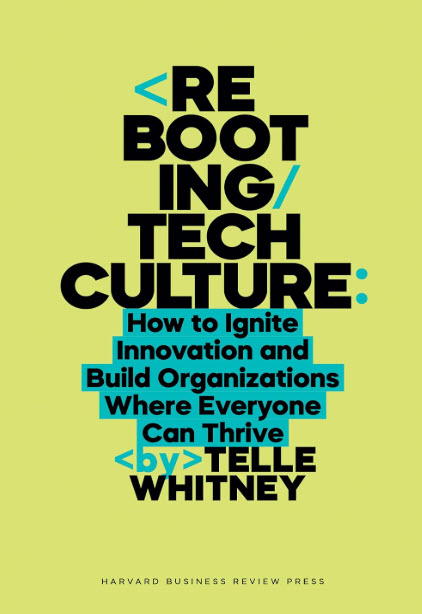Rebooting Tech Culture: How to Ignite Innovation and Build Organizations Where Everyone Can Thrive, by Telle Whitney. Boston: Harvard Business Review Press, 2025; 224 pages, $32.
Does tech culture have, as many maintain, a culture problem? Rebooting Tech Culture certainly takes that position, supported by numerous forms of evidence from personal stories to widely reported incidents and references to relevant research.
Further reading:
- An inside look: Resolving the danger surrounding NYC’s Citicorp Tower
- Companies can gain from thinking differently about sustainability, authors say
- In easy-to-understand manner, author stresses infrastructure’s importance

As forceful and compelling as the case that author Telle Whitney makes for that position, there is perhaps an even more interesting point here. Namely, that her prescription for changing that culture, for eliminating – or at least minimizing – that problem, sure sounds like a great blueprint for a tech business to follow, even if you completely disagreed that there was a widespread diversity problem or that underrepresented groups were persistently marginalized in many technology companies.
What is that prescription? Whitney calls it the “6 C’s” – creativity, courage, confidence, curiosity, communication, and community. Specifically, that all employees are encouraged and incentivized to develop, express, and embody those traits in their work and be rewarded for doing so.
The meat of Rebooting Tech Culture is given over to one complete chapter on each of those six C’s. In each case, the book breaks down what it means to foster those values, how they are often undermined or ignored (at least for certain people), and what actions a company can take to move in the right direction in that area.
These can range from modeling creative conflict resolution for creativity, actively soliciting feedback from nonparticipating employees to foster courage, and encouraging employees to find the true root causes of difficult technical challenges to develop curiosity.
Rebooting Tech Culture argues that fully committing to these values – not just paying lip service to things like sensitivity training and commitments to hire those from underrepresented groups – is the best way to create and sustain a naturally diverse workforce and inclusive culture that actually maximizes the value of all employees.
“I sincerely appreciate the intent of many of the programs that companies deploy to hire more employees from underrepresented groups,” Whitney writes. “However, creating significant change is not easy. … It requires a systemic approach to building environments that are truly supportive of inclusivity and creativity.” Or, as she also notes pithily: “You can’t just bring people into a dysfunctional culture and hope it will work out.”
Whitney brings a wealth of personal experience to the table for this discussion. Holding a Ph.D. in computer science from the California Institute of Technology, she worked for several technology companies, including during the wave of technological innovation that took place in the mid- to late-1980s and beyond, creating computer chips as well as the software behind them.
With friend and fellow computer scientist Anita Borg, in 1994 Whitney founded the Grace Hopper Celebration of Women in Computing Conference (honoring pioneering Rear Adm. Grace Hopper, one of the earliest female computer scientists). Whitney later served for 15 years as president and CEO of the Anita Borg Institute for Women in Technology, which organizes the conference among a variety of other activities.
In a sector that has been historically incredibly competitive and has grown only more so not just between individual companies but between nations, you would hope that companies would pursue any possible edge.
And Whitney points out that a 2018 McKinsey report concluded that companies who ranked in the top quartile for diversity were more likely to have better than average financial returns and also that a study of patents by the National Center for Women & Information Technology showed that mixed gender teams produced more frequently cited patents.
Clearly written and argued, Rebooting Tech Culture forces readers to contemplate whether successful technology companies are not just born but can be made – or made better – by a more thoughtful approach to leveraging all the human capital, ideas, and perspectives at their disposal.
Explore more Civil Engineering Source content on YouTube Shorts.



